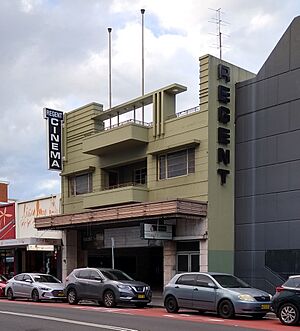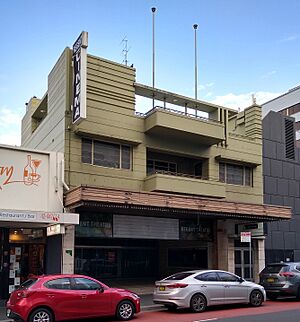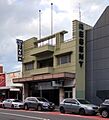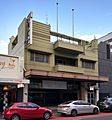Regent Theatre, Wollongong facts for kids
Quick facts for kids Regent Theatre |
|
|---|---|
 |
|
| Location | 197 Keira Street, Wollongong, City of Wollongong, New South Wales, Australia |
| Built | 1950–1954 |
| Architect | Reginald J. Magoffin Interior by Marion Hall Best |
| Owner | Apostolic Church Australia |
| Official name: Regent Theatre | |
| Type | state heritage (built) |
| Designated | 9 May 2005 |
| Reference no. | 1735 |
| Type | Cinema |
| Category | Recreation and Entertainment |
| Builders | Unknown |
| Lua error in Module:Location_map at line 420: attempt to index field 'wikibase' (a nil value). | |
The Regent Theatre is a special old building in Wollongong, Australia. It used to be a popular cinema and a place for live shows. It's located at 197 Keira Street.
The theatre was designed by Reginald J. Magoffin, and its amazing inside look was created by Marion Hall Best. It was built between 1950 and 1954. Because of its unique history and design, the Regent Theatre was added to the New South Wales State Heritage Register on May 9, 2005. This means it's an important building that needs to be protected.
Contents
History of the Regent Theatre
Early Days of Cinema in Illawarra
The story of the Regent Theatre is linked to a man named Herbert Wyndham Jones. He was a very important person in bringing movies to the Illawarra area. Originally, he was a store owner, but he became an entrepreneur, which means he started his own businesses.
By 1930, he was running the Princess Theatre in Corrimal. This was during the Great Depression, a time when many people didn't have jobs. The theatre even helped as a relief center. Herbert Jones spent a lot of money fixing up the theatre in 1931. He wanted to give people a chance to escape their worries by watching movies.
He first showed silent movies, but soon after, he brought in "talkies" (movies with sound). In 1931, he bought the Princess Theatre. His family owned it for 41 years until it was destroyed by fire in 1971.
Herbert Jones also helped the Balgownie School of Arts Committee in 1933 by restarting film showings there. He also started showing 16mm movies in Kembla Heights in the early 1940s. After he passed away in 1943, his son Maurice continued these showings.
In 1938, Herbert Jones also took over showing movies at the Wollongong Council's Town Hall Theatre. He brought in new ideas like "deaf aids" for people with hearing difficulties and focused on showing Australian movies. His wife continued running the Town Hall (Civic Theatre) until it closed in 1964.
The Jones family also introduced new technologies at the Civic Theatre. They installed a new sound system in 1951. They also started showing foreign-language films in 1953 and used a special wide-screen process called VistaVision in 1954. These new ideas helped them prepare for the even bigger innovations at the Regent Theatre.
Building the Regent Theatre
Herbert Jones bought the land for the Regent Theatre in 1934. He wanted to build a grand movie theatre there. In 1935, architect Reginald John Magoffin from Sydney drew up plans for a large theatre with a stage, auditorium, and many seats. The plans were very ambitious, showing a beautiful courtyard and modern features.
Jones started a new company called South Coast Theatres Ltd to help pay for the building. The company aimed to create a theatre with comfortable seating, spacious lounges, and special lighting. They believed Wollongong needed a new theatre because so many people wanted to see movies.
However, building the theatre faced many delays. Herbert Jones said that problems with industry, money, and politics stopped the work. Then, World War II also caused more delays. Sadly, Herbert Jones passed away in 1943 before the project even started.
His wife, Emily Vaughan Jones, and his son, Maurice, took over the family's movie business. In 1947, they restarted the plans for the Keira Street theatre. This time, the project was approved. Magoffin updated the plans to include offices above the entrance area, which would help bring in money for the main theatre later.
Construction finally began in February 1950, but it was very slow. The offices were not finished until 1954. Many local people thought the entrance area was the whole theatre at first. But then, the much larger auditorium building started to rise behind it.
The beautiful entrance area, called the vestibule, was designed by famous interior designers Marion Hall Best and Janet Single. Marion Hall Best, born in 1905, became one of Sydney's first independent decorators. She was known for her bold use of color and modern designs. Her style included bright walls, modern furniture, and unique fabrics.
The Regent Theatre finally opened on Boxing Day in 1957. This was 23 years after Herbert Jones first bought the land!
Theatre Operations and Modern Changes
Over the years, the Regent Theatre introduced many exciting features:
- In 1961, it had its first Cinemascope screening, which is a wide-screen movie format.
- A special stereophonic sound system was installed in 1963 for the movie "South Pacific."
- A huge curved screen (32 feet by 19 feet) was added in 1967 for the movie "My Fair Lady."
- The projection room had advanced Phillips Cinemeccanica 70mm projectors.
- Later, Dolby system speakers were added for even better sound.
The theatre was a tribute to the Jones family's hard work. It stayed in their family until Herbert Jones's daughter, Rowena Milgrove, passed away in 2004. She had planned to close the cinema permanently due to money problems just before her death.
In 2002, there was a plan to tear down the building, but it didn't happen. In 2005, the Gateway City Church bought the theatre for $3.5 million. They spent another $1 million on improvements and used it for live music events sometimes.
In 2016, the owners painted the theatre's outside a special olive green color. This was because heritage experts found that it was the building's original color.
The church put the building up for sale again in 2017. In 2018, it seemed like a buyer was found who wanted to bring it back as a theatre, but that sale didn't go through. However, in early 2020, a group of local businesses bought it. They plan to restore the theatre and reopen it as a live performance venue. They want to remove the seats in the main area to create standing room and turn the old candy bars into new bars.
What the Regent Theatre Looks Like
The outside of the Regent Theatre has a strong, geometric design. It mixes styles like Functionalist and Art Deco. The inside of the theatre, especially the main auditorium, is "beautifully simple." It has a criss-cross pattern on the ceiling with hundreds of tiny "star-lights." The ceiling curves and hides lights that used to glow. The walls and ceiling inside are painted a gray-green color, which contrasts with the orange-red stage curtain.
Around the stage, there's a plain plaster area where hidden lights used to be. On each side of the auditorium, there are plaster designs showing mythological scenes with a star or sun shape.
From the stage, you can see clusters of lights under the balcony, Dolby stereo speakers, and the projection room at the back.
The projection room has impressive equipment, including two old Westrex machines and two Philips Todd-AO DP-70 projectors. These are similar to projectors used in other famous Sydney theatres.
You enter the Regent Theatre through five double glass doors on Keira Street. These lead into a long entrance hall with a special terrazzo floor. On one side, there are display cases, and on the other, a long candy bar and ticket office. The walls and ceiling of this entrance area have bright, multi-colored glass, which was designed by Marion Hall Best.
At the far end of the entrance hall, there are unique pumpkin-shaped lanterns hanging at different heights.
There's a divided staircase that leads up to the mezzanine lounge. This is a large space under the Dress Circle (the upper seating area). The design here has an Asian feel, with bamboo-patterned wallpaper on the ceiling and tropical plants.
At each end of this lounge, another staircase leads to the dress circle, offering a stunning view of the starry auditorium ceiling.
The Regent Theatre shows many influences from other countries, including the "atmospheric" theatre style. It seems to be inspired by the Museum of Modern Art in New York.
Condition of the Theatre
As of 2002, the theatre was in good condition and well looked after.
Changes Over Time
Some small changes have happened over the years. The neon sign on the outside awnings is gone. New "fairy" lights were added to the ceiling above the street entrance. A fountain in the foyer was removed because of damage and replaced with a decorative panel of plants and animals.
Why the Regent Theatre is Important
The Regent Theatre is very important to the history of New South Wales for several reasons:
- Its interior design by Marion Hall Best is rare and outstanding. It's one of the few remaining examples of her unique "glazing" paintwork in a public space.
- It's a great example of design work by professional women in the mid-20th century in NSW.
- It's a rare and well-preserved large cinema.
- The building's outside was designed in the Art Deco style in the 1930s, even though it was built in the 1950s.
- The theatre is important because it helped introduce wide-screen movie technology to cinemas in NSW. It still has its wide screen and large "picture palace" style auditorium.
- It's also important because of its connection to Herbert Wyndham Jones. It shows how successful he was in managing cinemas in the Illawarra region.
- The Regent Theatre has social importance for the thousands of people who watched movies there for over 50 years. When there were talks of tearing it down, many people in the community showed how much they cared about it.
The Regent Theatre was added to the New South Wales State Heritage Register on May 9, 2005, because it meets several important criteria.
It shows how cultural history developed in New South Wales. The Regent Theatre is a rare, large cinema that shows the importance of movies as entertainment in the mid-20th century in NSW.
It is strongly connected to important people in NSW history. The theatre is important because of its connection to Marion Hall Best, who designed the inside. Her work here is one of her most important public projects and one of the few examples of her work that still exists. She was a very influential interior designer in Australia. It's also important because of Herbert Wyndham Jones and his family, who pioneered movies in the Illawarra region.
It shows great creative or technical achievement. The Regent Theatre's interior design by Marion Hall Best is outstanding. It's a major work by a leading modernist designer. The theatre's original large size and wide-screen format make it one of the few "picture palace" style cinemas left in NSW that still looks like it did.
It has a strong connection with a community or group. The Regent Theatre is very important to the people of the region who went there for movies for over 50 years. The community's strong reaction when it was almost demolished shows how much they value it.
It can help us learn about NSW's cultural history. The Regent Theatre is a surviving large cinema from an earlier time. It shows how wide-screen technology was introduced in NSW cinemas and still has its original layout.
It is rare or endangered. The Regent Theatre is rare because of its intact interior design by Marion Hall Best, which might be her only surviving commercial interior. It's also one of the few grand cinemas left in NSW that is still mostly original.
It shows the main features of its type of cultural place. The Regent is a good example of a cinema from the 1950s, when the movie industry was growing with new technologies like "Cinemascope."
Images for kids




